When Trees Are Not an Option: Perennial Vines as a Complementary Strategy for Mitigating the Summer Warming of an Urban Microclimate
Abstract
:1. Introduction
2. Materials and Methods
3. Results
3.1. Vine Characteristics
3.2. Meteorological Data
3.3. Sun and Shade Temperature Differentials
3.4. The South-Facing Versus the West-Facing Wall
3.5. Degree Hour Difference (DHD)
3.6. Meteorological Conditions and DHD
− 0.158 × RH + 0.009 × (D × I) − 0.197 × (AT × W) + 0.621 × (D × W)
r2 = 0.736, p < 0.001
− 1.418 × W + 0.008(D × I) + 0.002(AT × I)
r2 = 0.852, p < 0.001
4. Discussion
5. Conclusions
Author Contributions
Funding
Data Availability Statement
Acknowledgments
Conflicts of Interest
References
- Hobbie, S.E.; Baker, L.A.; Buyarski, C.; Nidzgorski, D.; Finlay, J.C. Decomposition of Tree Leaf Litter on Pavement: Implications for Urban Water Quality. Urban. Ecosyst. 2014, 17, 369–385. [Google Scholar] [CrossRef]
- Taha, H. Urban Climates and Heat Islands: Albedo, Evapotranspiration, and Anthropogenic Heat. Energy Build. 1997, 25, 99–103. [Google Scholar] [CrossRef]
- Akbari, H.; Taha, H. The Impact of Trees and White Surfaces on Residential Heating and Cooling Energy Use in Four Canadian Cities. Energy 1992, 17, 141–149. [Google Scholar] [CrossRef]
- Oke, T.R. City Size and the Urban Heat Island. Atmos. Environ. 1973, 7, 769–779. [Google Scholar] [CrossRef]
- Keith, L.; Meerow, S.; Wagner, T. Planning for Extreme Heat: A Review. J. Extrem. Events 2019, 6, 2050003. [Google Scholar] [CrossRef]
- Gao, Z.; Hou, Y.; Chen, W. Enhanced Sensitivity of the Urban Heat Island Effect to Summer Temperatures Induced by Urban Expansion. Environ. Res. Lett. 2019, 14, 094005. [Google Scholar] [CrossRef]
- Solecki, W.D.; Rosenzweig, C.; Parshall, L.; Pope, G.; Clark, M.; Cox, J.; Wiencke, M. Mitigation of the Heat Island Effect in Urban New Jersey. Environ. Hazards 2005, 6, 39–49. [Google Scholar] [CrossRef]
- Marando, F.; Heris, M.P.; Zulian, G.; Udías, A.; Mentaschi, L.; Chrysoulakis, N.; Parastatidis, D.; Maes, J. Urban Heat Island Mitigation by Green Infrastructure in European Functional Urban Areas. Sustain. Cities Soc. 2022, 77, 103564. [Google Scholar] [CrossRef]
- Parker, J.H. Landscaping to Reduce the Energy Used in Cooling Buildings. J. For. 1983, 81, 82–105. [Google Scholar] [CrossRef]
- Rosenfeld, A.H.; Akbari, H.; Bretz, S.; Fishman, B.L.; Kurn, D.M.; Sailor, D.; Taha, H. Mitigation of Urban Heat Islands: Materials, Utility Programs, Updates. Energy Build. 1995, 22, 255–265. [Google Scholar] [CrossRef]
- Akbari, H.; Pomerantz, M.; Taha, H. Cool Surfaces and Shade Trees to Reduce Energy Use and Improve Air Quality in Urban Areas. Sol. Energy 2001, 70, 295–310. [Google Scholar] [CrossRef]
- Patz, J.A.; Campbell-Lendrum, D.; Holloway, T.; Foley, J.A. Impact of Regional Climate Change on Human Health. Nature 2005, 438, 310–317. [Google Scholar] [CrossRef]
- Lin, J.; Brown, R. Integrating Microclimate into Landscape Architecture for Outdoor Thermal Comfort: A Systematic Review. Land 2021, 10, 196. [Google Scholar] [CrossRef]
- Turner, V.K.; French, E.M.; Dialesandro, J.; Middel, A.; M Hondula, D.; Weiss, G.B.; Abdellati, H. How Are Cities Planning for Heat? Analysis of United States Municipal Plans. Environ. Res. Lett. 2022, 17, 064054. [Google Scholar] [CrossRef]
- Kershaw, S.E.; Millward, A.A. A Spatio-Temporal Index for Heat Vulnerability Assessment. Environ. Monit. Assess. 2012, 184, 7329–7342. [Google Scholar] [CrossRef]
- McGeehin, M.A.; Mirabelli, M. The Potential Impacts of Climate Variability and Change on Temperature-Related Morbidity and Mortality in the United States. Environ. Health Perspect. 2001, 109, 185–189. [Google Scholar] [CrossRef]
- Cheng, C.S.; Campbell, M.; Li, Q.; Li, G.; Auld, H.; Day, N.; Pengelly, D.; Gingrich, S.; Klaassen, J.; MacIver, D.; et al. Differential and Combined Impacts of Extreme Temperatures and Air Pollution on Human Mortality in South-Central Canada. Part I: Historical Analysis. Air Qual. Atmos. Health 2008, 1, 209–222. [Google Scholar] [CrossRef]
- Qi, J.; He, B.-J. Urban Heat Mitigation Strategies. In Climate Change and Cooling Cities. Urban Sustainability; Cheshmehzangi, A., He, B., Sharifi, A., Matzarakis, A., Eds.; Springer: Singapore, 2023; pp. 21–44. [Google Scholar]
- Sawka, M.; Millward, A.A.; Mckay, J.; Sarkovich, M. Growing Summer Energy Conservation through Residential Tree Planting. Landsc. Urban. Plan. 2013, 113, 1–9. [Google Scholar] [CrossRef]
- Millward, A.A.; Sabir, S. Benefits of a Forested Urban Park: What Is the Value of Allan Gardens to the City of Toronto, Canada? Landsc. Urban Plan. 2011, 100, 177–188. [Google Scholar] [CrossRef]
- De Kimpe, C.R.; Morel, J.L. Urban Soil Management: A Growing Concern. Soil Sci. 2000, 165, 31–40. [Google Scholar] [CrossRef]
- Ordóñez, C.; Sabetski, V.; Millward, A.A.; Steenberg, J.W.N.; Grant, A.; Urban, J. The Influence of Abiotic Factors on Street Tree Condition and Mortality in a Commercial-Retail Streetscape. Arboric. Urban For. 2018, 44, 133–145. [Google Scholar] [CrossRef]
- Ordóñez, C.; Duinker, P.N. Assessing the Vulnerability of Urban Forests to Climate Change. Environ. Rev. 2014, 22, 311–321. [Google Scholar] [CrossRef]
- Ordóñez, C.; Grant, A.; Millward, A.A.; Steenberg, J.; Sabetski, V. Developing Performance Indicators for Nature-Based Solution Projects in Urban Areas: The Case of Trees in Revitalized Commercial Spaces. Cities Environ. 2019, 12, 1. Available online: https://digitalcommons.lmu.edu/cate/vol12/iss1/1 (accessed on 15 November 2023).
- Riley, B. The State of the Art of Living Walls: Lessons Learned. Build. Environ. 2017, 114, 219–232. [Google Scholar] [CrossRef]
- Coma, J.; Pérez, G.; de Gracia, A.; Burés, S.; Urrestarazu, M.; Cabeza, L.F. Vertical Greenery Systems for Energy Savings in Buildings: A Comparative Study between Green Walls and Green Facades. Build. Environ. 2017, 111, 228–237. [Google Scholar] [CrossRef]
- Köhler, M. Green Facades—A View Back and Some Visions. Urban Ecosyst. 2008, 11, 423–436. [Google Scholar] [CrossRef]
- Dunnett, N.; Kingsbury, N. Planting Green Roofs and Living Walls; Timber: Portland, OR, USA, 2008. [Google Scholar]
- Irga, P.J.; Torpy, F.R.; Griffin, D.; Wilkinson, S.J. Vertical Greening Systems: A Perspective on Existing Technologies and New Design Recommendation. Sustainability 2023, 15, 6014. [Google Scholar] [CrossRef]
- Independent Electricity System Operator Demand Overview: Historical Demand. Available online: https://www.ieso.ca/en/Power-Data/Demand-Overview/Historical-Demand (accessed on 5 October 2023).
- Sherman, P.; Lin, H.; McElroy, M. Projected Global Demand for Air Conditioning Associated with Extreme Heat and Implications for Electricity Grids in Poorer Countries. Energy Build. 2022, 268, 112198. [Google Scholar] [CrossRef]
- Perini, K.; Ottelé, M.; Fraaij, A.L.A.; Haas, E.M.; Raiteri, R. Vertical Greening Systems and the Effect on Air Flow and Temperature on the Building Envelope. Build. Environ. 2011, 46, 2287–2294. [Google Scholar] [CrossRef]
- Bao, S.; Zou, S.; Zhao, M.; Chen, Q.; Li, B. Experimental Study on the Modular Vertical Greening Shading in Summer. Int. J. Environ. Res. Public Health 2022, 19, 11648. [Google Scholar] [CrossRef]
- Susorova, I.; Azimi, P.; Stephens, B. The Effects of Climbing Vegetation on the Local Microclimate, Thermal Performance, and Air Infiltration of Four Building Facade Orientations. Build. Environ. 2014, 76, 113–124. [Google Scholar] [CrossRef]
- Charoenkit, S.; Yiemwattana, S. Living Walls and Their Contribution to Improved Thermal Comfort and Carbon Emission Reduction: A Review. Build. Environ. 2016, 105, 82–94. [Google Scholar] [CrossRef]
- Hoyano, A. Climatological Uses of Plants for Solar Control and the Effects on the Thermal Environment of a Building. Energy Build. 1988, 11, 181–199. [Google Scholar] [CrossRef]
- Wong, N.H.; Kwang Tan, A.Y.; Chen, Y.; Sekar, K.; Tan, P.Y.; Chan, D.; Chiang, K.; Wong, N.C. Thermal Evaluation of Vertical Greenery Systems for Building Walls. Build. Environ. 2010, 45, 663–672. [Google Scholar] [CrossRef]
- Chen, Q.; Li, B.; Liu, X. An Experimental Evaluation of the Living Wall System in Hot and Humid Climate. Energy Build. 2013, 61, 298–307. [Google Scholar] [CrossRef]
- Nagdeve, S.S.; Manchanda, S.; Dewan, A. Thermal Performance of Indirect Green Façade in Composite Climate of India. Build. Environ. 2023, 230, 109998. [Google Scholar] [CrossRef]
- Kontoleon, K.J.; Eumorfopoulou, E.A. The Effect of the Orientation and Proportion of a Plant-Covered Wall Layer on the Thermal Performance of a Building Zone. Build. Environ. 2010, 45, 1287–1303. [Google Scholar] [CrossRef]
- Holm, D. Thermal Improvement by Means of Leaf Cover on External Walls—A Simulation Model. Energy Build. 1989, 14, 19–30. [Google Scholar] [CrossRef]
- Ip, K.; Lam, M.; Miller, A. Shading Performance of a Vertical Deciduous Climbing Plant Canopy. Build. Environ. 2010, 45, 81–88. [Google Scholar] [CrossRef]
- Susorova, I.; Angulo, M.; Bahrami, P.; Stephens, B. A Model of Vegetated Exterior Facades for Evaluation of Wall Thermal Performance. Build. Environ. 2013, 67, 1–13. [Google Scholar] [CrossRef]
- Pérez, G.; Coma, J.; Martorell, I.; Cabeza, L.F. Vertical Greenery Systems (VGS) for Energy Saving in Buildings: A Review. Renew. Sustain. Energy Rev. 2014, 39, 139–165. [Google Scholar] [CrossRef]
- Ckitchfield, W. Shoot Growth and Leaf Dimorphism in Boston Ivy (Parthenocissus Tricuspidata). Am. J. Bot. 1970, 57, 535–542. [Google Scholar] [CrossRef]
- Tenenbaum, F. Taylor’s Encyclopedia of Garden Plants; Houghton Mifflin: Boston, MA, USA, 2003. [Google Scholar]
- He, T.; Zhang, L.; Xin, H.; Deng, W. Morphology and Mechanics of the Adhesive Disc of Liana Parthenocissus Tricuspidata. Pure Appl. Chem. 2010, 82, 91–96. [Google Scholar] [CrossRef]
- Simpson, J.; McPherson, E. Potential of Tree Shade for Reducing Residential Energy Use in California. J. Arboric. 1996, 22, 10–18. [Google Scholar] [CrossRef]
- Givoni, B. Climate Considerations in Building and Urban Design; Wiley: Hoboken, NJ, USA, 1998. [Google Scholar]
- ANSI/ASHRAE Standard 55: 2017; Thermal Environmental Conditions for Human Occupancy. ASHRAE: Atlanta, NW, USA, 2017.
- Akbari, H.; Kurn, D.M.; Bretz, S.E.; Hanford, J.W. Peak Power and Cooling Energy Savings of Shade Trees. Energy Build. 1997, 25, 139–148. [Google Scholar] [CrossRef]
- Fountain, M.; Brager, G.; de Dear, R. Expectations of Indoor Climate Control. Energy Build. 1996, 24, 179–182. [Google Scholar] [CrossRef]
- Allison, P. Multiple Regression: A Primer; SAGE Publications: New York, NY, USA, 1998. [Google Scholar]
- Pérez, G.; Coma, J.; Sol, S.; Cabeza, L.F. Green Facade for Energy Savings in Buildings: The Influence of Leaf Area Index and Facade Orientation on the Shadow Effect. Appl. Energy 2017, 187, 424–437. [Google Scholar] [CrossRef]
- Noodén, L.; Leopold, A. (Eds.) Senescence and Aging in Plants; Elsevier: Amsterdam, The Netherlands, 1988; ISBN 9780125209205. [Google Scholar]
- Jim, C.Y. Urban Soil Characteristics and Limitations for Landscape Planting in Hong Kong. Landsc. Urban Plan. 1998, 40, 235–249. [Google Scholar] [CrossRef]
- DeepRoot Soil Volume Minimums for Street Trees Organized by State/Province. Available online: https://www.deeproot.com/blog/blog-entries/soil-volume-minimums-organized-by-stateprovince-2/ (accessed on 1 November 2023).
- DeepRoot Soil Volume Recommendations for Vines, Hedges, and Palms. Available online: https://www.deeproot.com/blog/blog-entries/soil-volume-recommendations-for-vines-hedges-and-palms/ (accessed on 1 November 2023).
- Lu, J.W.; Svendsen, E.S.; Campbell, L.K.; Greenfeld, J.; Braden, J. Biological, Social, and Urban Design Factors Affecting Young Street Tree Mortality in New York City. Cities Environ. (CATE) 2011, 3, 5. [Google Scholar]
- Akbari, H. Shade Trees Reduce Building Energy Use and CO2 Emissions from Power Plants. Environ. Pollut. 2002, 116, S119–S126. [Google Scholar] [CrossRef] [PubMed]
- Donovan, G.H.; Butry, D.T. The Value of Shade: Estimating the Effect of Urban Trees on Summertime Electricity Use. Energy Build. 2009, 41, 662–668. [Google Scholar] [CrossRef]
- Tams, L.; Paton, E.N.; Kluge, B. Impact of Shading on Evapotranspiration and Water Stress of Urban Trees. Ecohydrology 2023, 16, e2556. [Google Scholar] [CrossRef]
- Vox, G.; Blanco, I.; Fuina, S.; Campiotti, C.A.; Mugnozza, G.S.; Schettini, E. Evaluation of Wall Surface Temperatures in Green Facades. In Proceedings of the Institution of Civil Engineers—Engineering Sustainability; ICE Publishing: Leeds, UK, 2017; Volume 170, pp. 334–344. [Google Scholar]
- Safikhani, T.; Baharvand, M. Evaluating the Effective Distance between Living Walls and Wall Surfaces. Energy Build. 2017, 150, 498–506. [Google Scholar] [CrossRef]
- Blanco, I.; Convertino, F. Thermal Performance of Green Façades: Research Trends Analysis Using a Science Mapping Approach. Sustainability 2023, 15, 9981. [Google Scholar] [CrossRef]
- Millward, A.A.; Torchia, M.; Laursen, A.E.; Rothman, L.D. Vegetation Placement for Summer Built Surface Temperature Moderation in an Urban Microclimate. Environ. Manag. 2014, 53, 1043–1057. [Google Scholar] [CrossRef]
- Ottelé, M.; Perini, K. Comparative Experimental Approach to Investigate the Thermal Behaviour of Vertical Greened Façades of Buildings. Ecol. Eng. 2017, 108, 152–161. [Google Scholar] [CrossRef]
- Perini, K.; Ottelé, M.; Haas, E.; Raiteri, R. Greening the Building Envelope, Facade Greening and Living Wall Systems. Open J. Ecol. 2011, 1, 1–8. [Google Scholar] [CrossRef]
- Besir, A.B.; Cuce, E. Green Roofs and Facades: A Comprehensive Review. Renew. Sustain. Energy Rev. 2018, 82, 915–939. [Google Scholar] [CrossRef]
- Cameron, R.W.F.; Taylor, J.E.; Emmett, M.R. What’s ‘Cool’ in the World of Green Façades? How Plant Choice Influences the Cooling Properties of Green Walls. Build. Environ. 2014, 73, 198–207. [Google Scholar] [CrossRef]
- Höppe, P. The Physiological Equivalent Temperature—A Universal Index for the Biometeorological Assessment of the Thermal Environment. Int. J. Biometeorol. 1999, 43, 71–75. [Google Scholar] [CrossRef] [PubMed]
- Narimani, N.; Karimi, A.; Brown, R.D. Effects of Street Orientation and Tree Species Thermal Comfort within Urban Canyons in a Hot, Dry Climate. Ecol. Inform. 2022, 69, 101671. [Google Scholar] [CrossRef]
- Ketterer, C.; Matzarakis, A. Mapping the Physiologically Equivalent Temperature in Urban Areas Using Artificial Neural Network. Landsc. Urban Plan. 2016, 150, 1–9. [Google Scholar] [CrossRef]

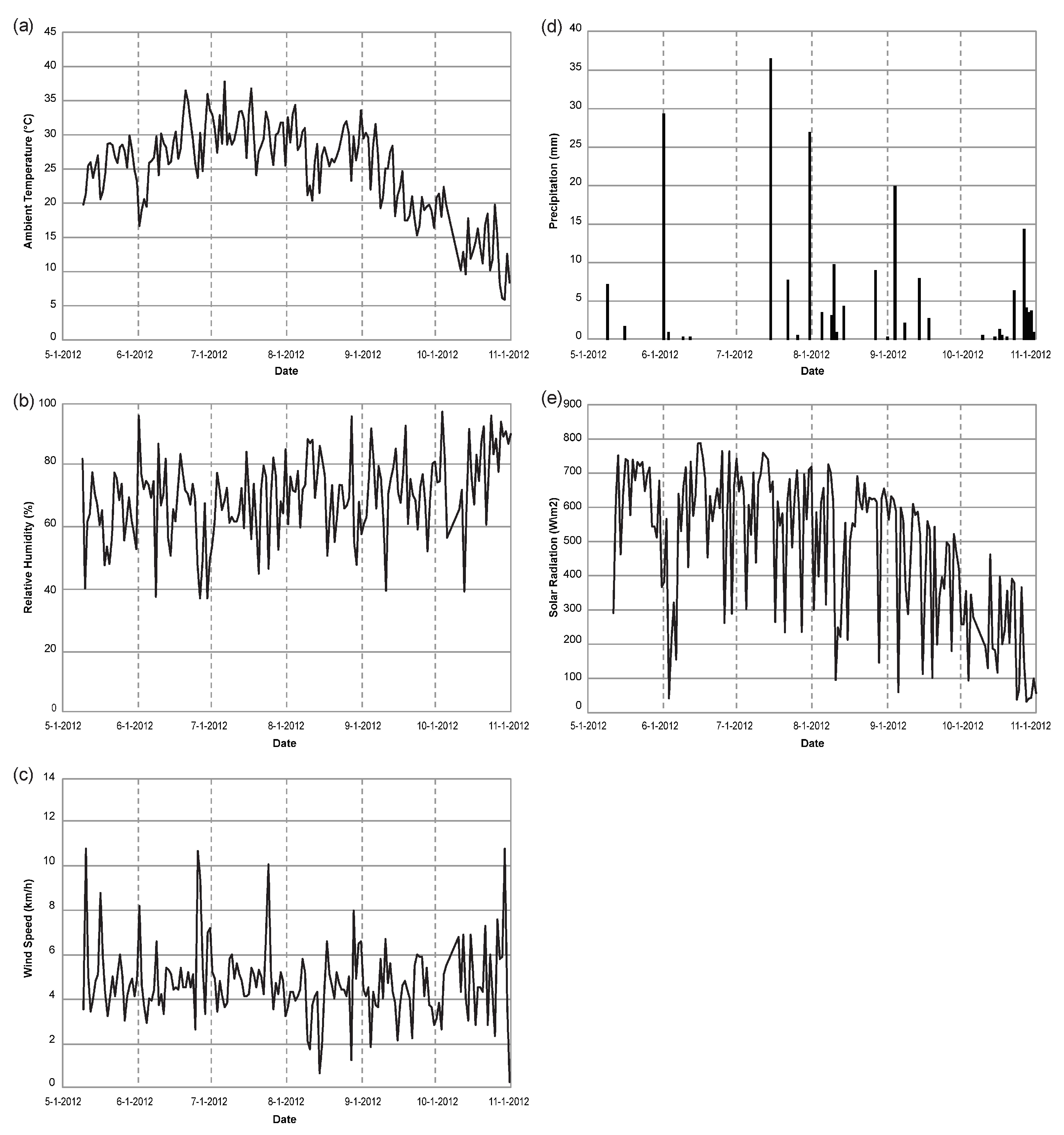
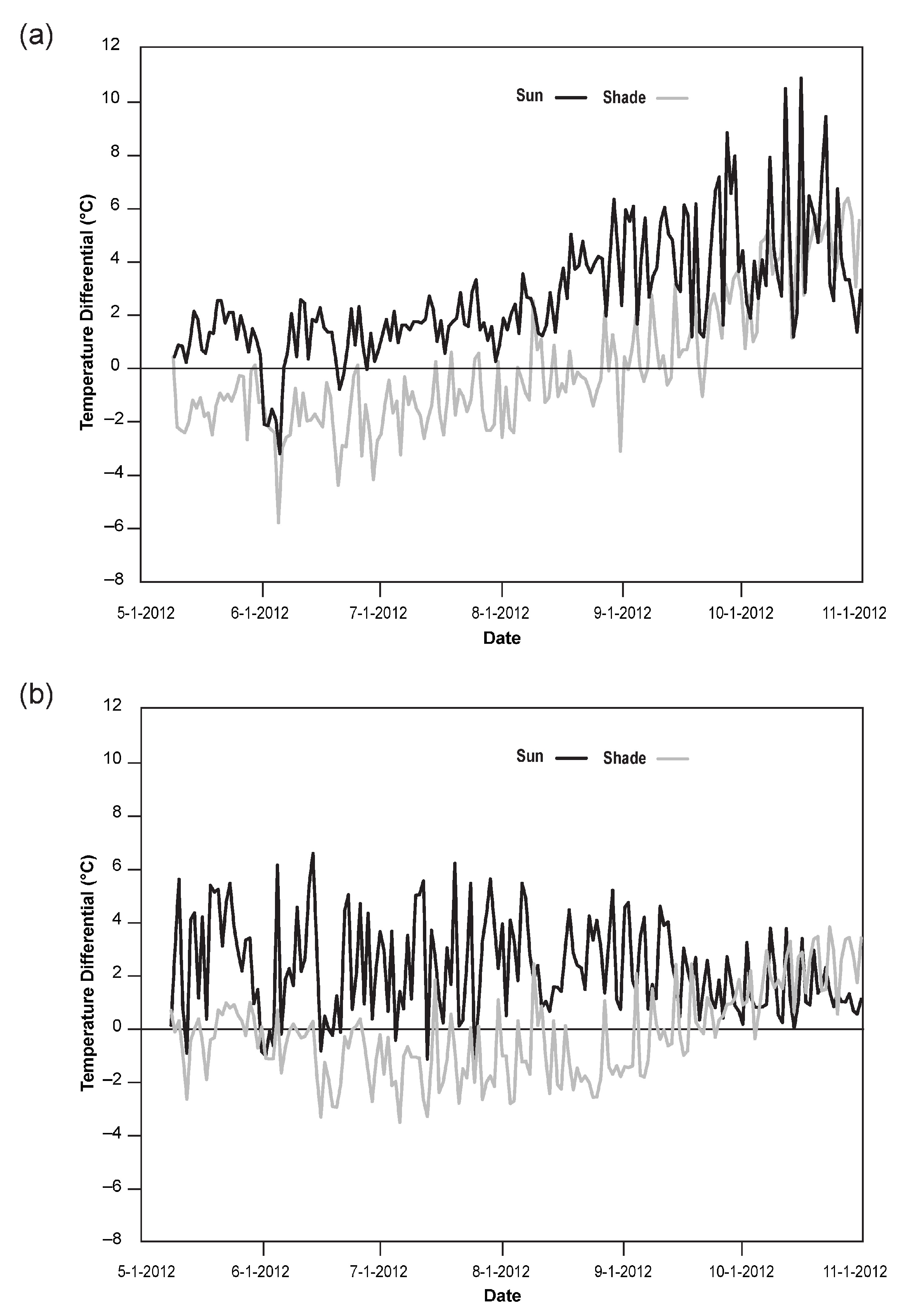

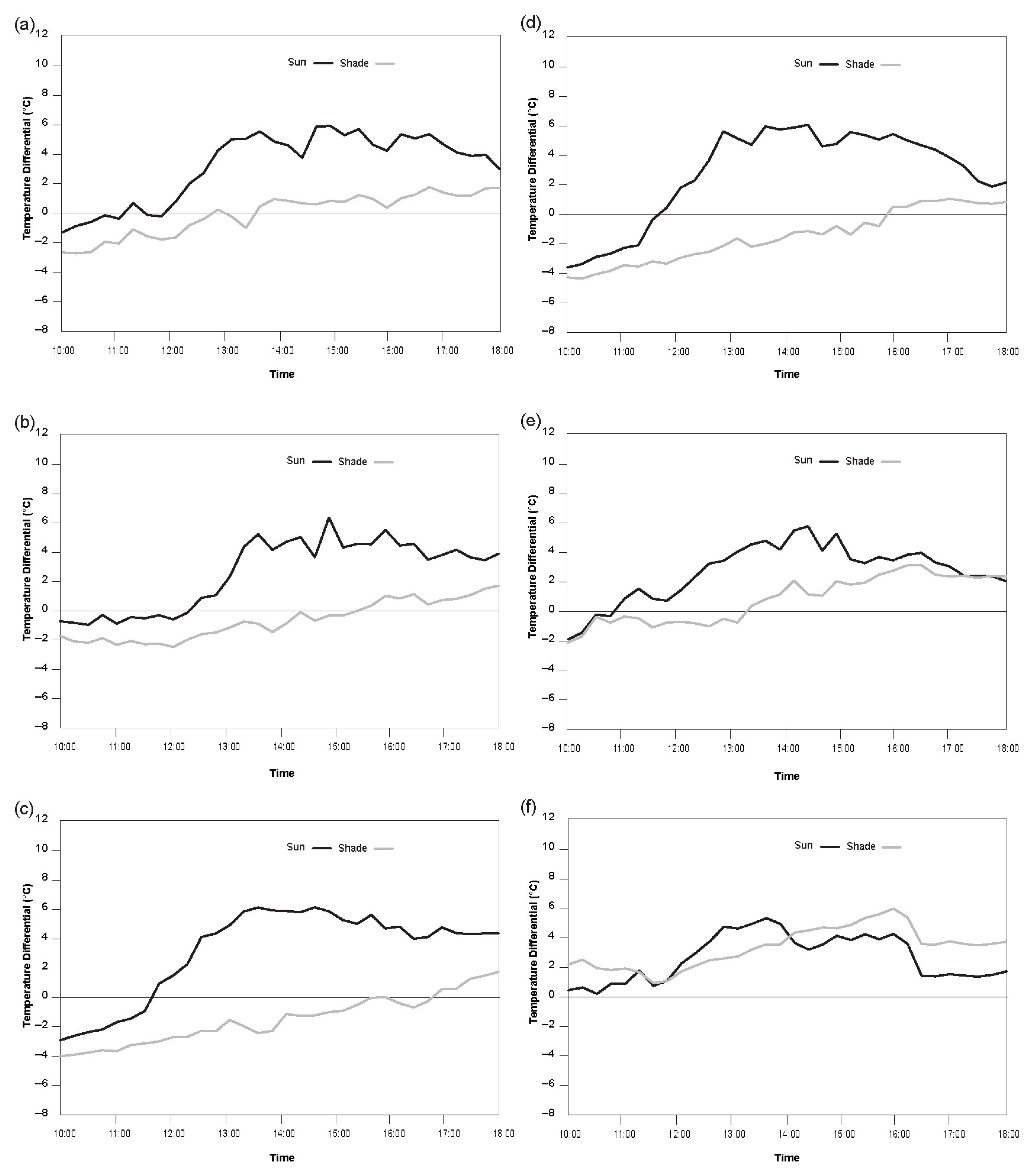
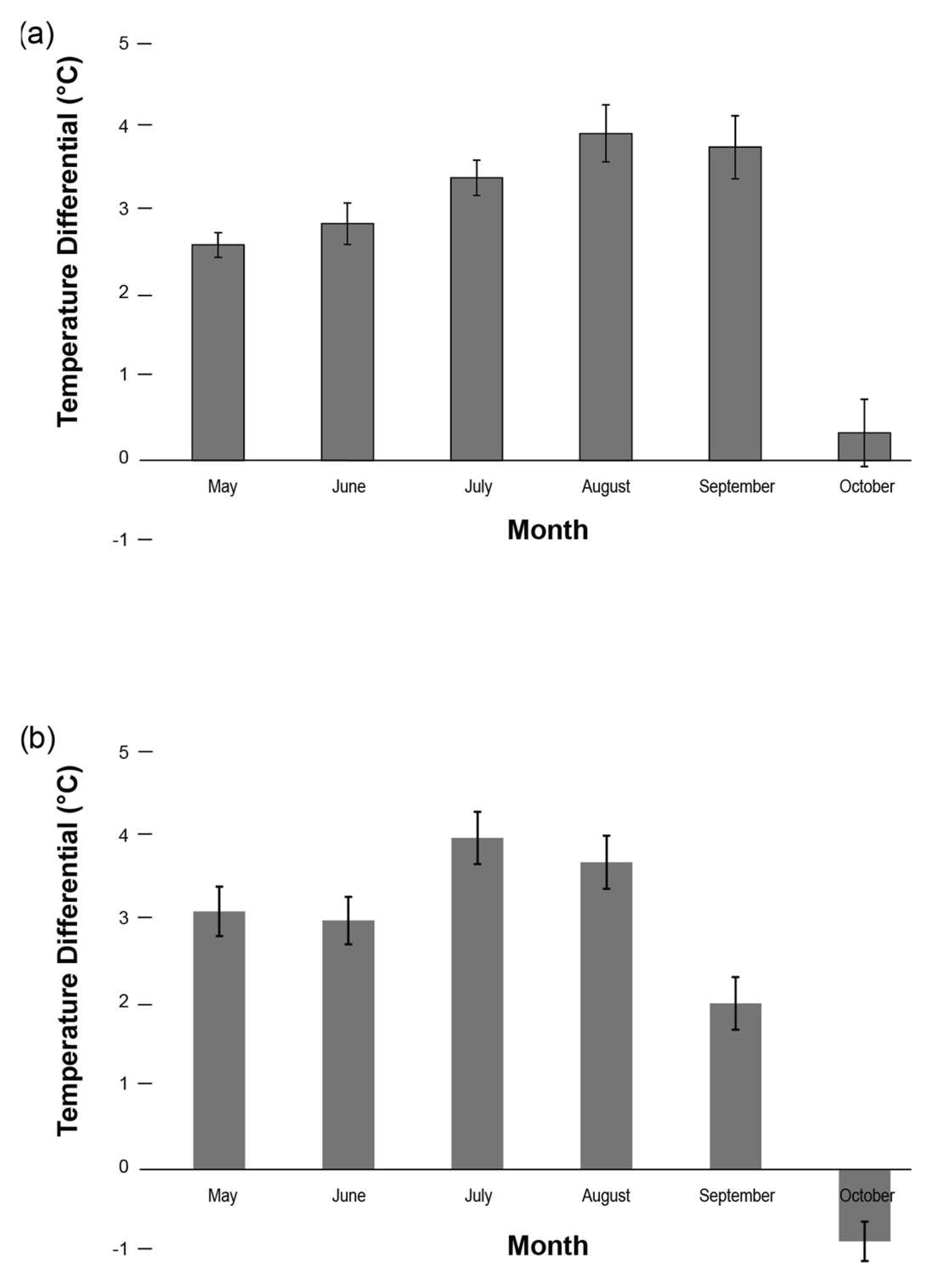
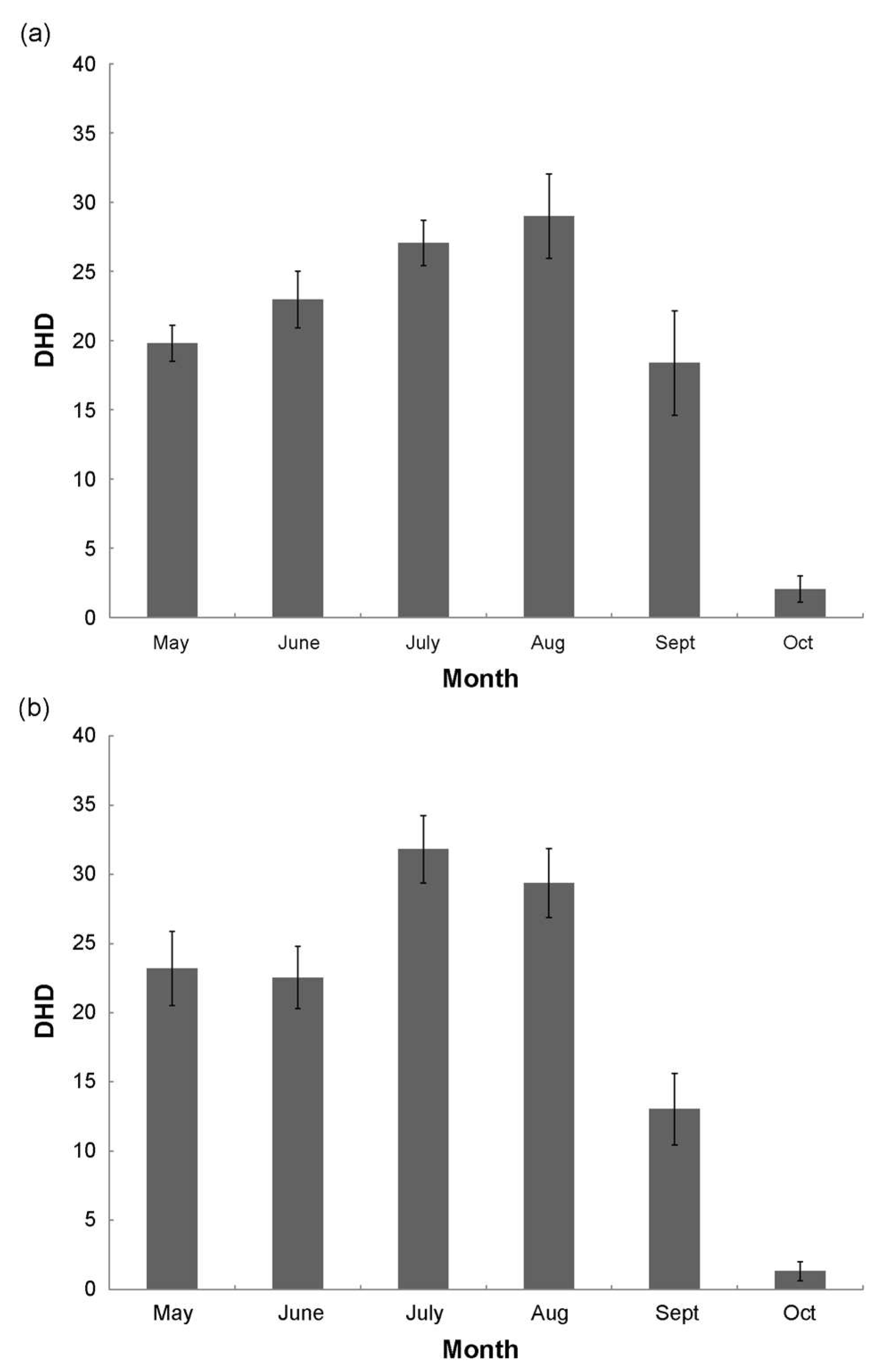
| May | June | July | August | September | October | |
|---|---|---|---|---|---|---|
| South (Shade to Sun) | (-) 2.6 ** | (-) 2.8 * | (-) 3.4 *** | (-) 3.9 *** | (-) 3.7 ** | ns |
| West (Shade to Sun) | (-) 3.1 * | (-) 3.0 * | (-) 4.0 *** | (-) 3.5 *** | ns | ns |
| Differential (South to West) | ns | ns | ns | ns | (-) 1.8 *** | (-) 1.2 * |
Disclaimer/Publisher’s Note: The statements, opinions and data contained in all publications are solely those of the individual author(s) and contributor(s) and not of MDPI and/or the editor(s). MDPI and/or the editor(s) disclaim responsibility for any injury to people or property resulting from any ideas, methods, instructions or products referred to in the content. |
© 2024 by the authors. Licensee MDPI, Basel, Switzerland. This article is an open access article distributed under the terms and conditions of the Creative Commons Attribution (CC BY) license (https://creativecommons.org/licenses/by/4.0/).
Share and Cite
Millward, A.A.; Blake, M. When Trees Are Not an Option: Perennial Vines as a Complementary Strategy for Mitigating the Summer Warming of an Urban Microclimate. Buildings 2024, 14, 416. https://doi.org/10.3390/buildings14020416
Millward AA, Blake M. When Trees Are Not an Option: Perennial Vines as a Complementary Strategy for Mitigating the Summer Warming of an Urban Microclimate. Buildings. 2024; 14(2):416. https://doi.org/10.3390/buildings14020416
Chicago/Turabian StyleMillward, Andrew A., and Michelle Blake. 2024. "When Trees Are Not an Option: Perennial Vines as a Complementary Strategy for Mitigating the Summer Warming of an Urban Microclimate" Buildings 14, no. 2: 416. https://doi.org/10.3390/buildings14020416





